|
CHAPTER II.
The Common Frog | ||
2. CHAPTER II.
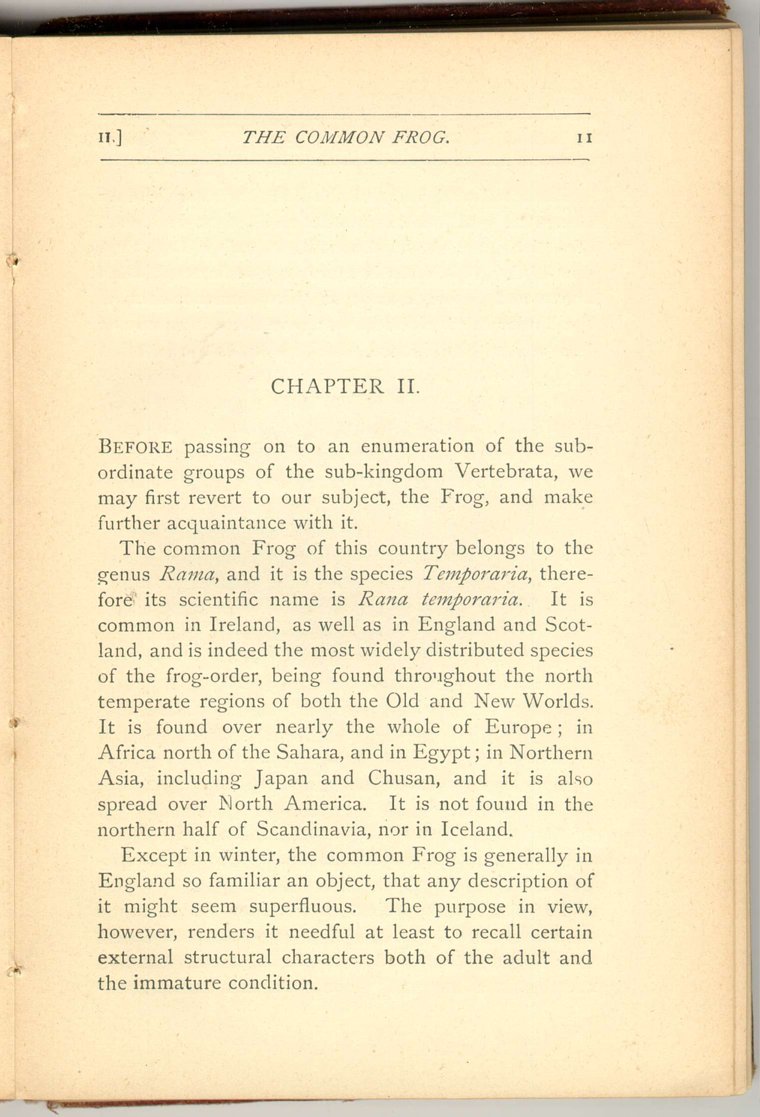 [Description:
Image of page 11.
]
[Description:
Image of page 11.
]
Before passing on to an enumeration
of the sub-ordinate groups of the sub-kingdom
Vertebrata, we may first revert to our subject, the
Frog, and make further acquaintance with it.
The common Frog of this country belongs to the genus Rama, and it is the species Temporaria, there fore its scientific name is Rana temporaria. It is common in Ireland, as well as in England and Scotland, and is indeed the most widely distributed species of the frog-order, being found throughout the north temperate regions of both the Old and New Worlds. It is found over nearly the whole of Europe; in Africa north of the Sahara, and in Egypt; in Northern Asia, including Japan and Chusan, and it is also spread over North America. It is not found in the northern half of Scandinavia, nor in Iceland.
Except in winter, the common Frog is generally in England so familiar an object, that any description of it might seem superfluous. The purpose in view, however, renders it needful at least to recall certain external structural characters both of the adult and the immature condition.
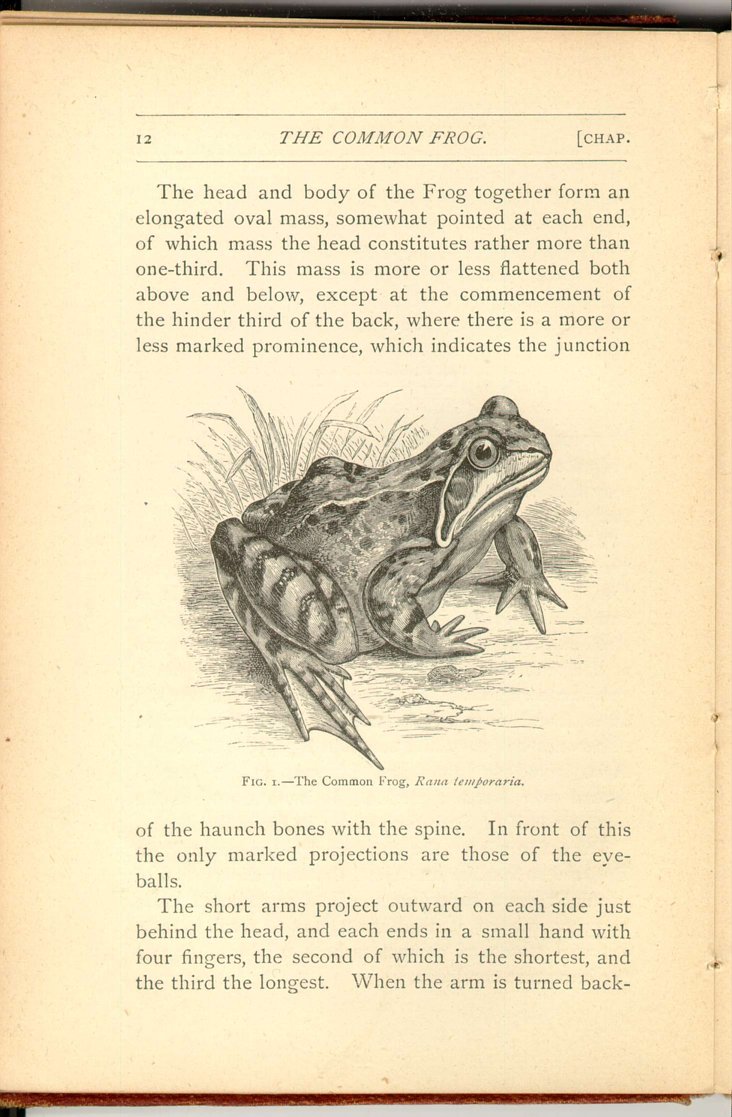 [Description:
Image of page 12.
]
[Description:
Image of page 12.
]
The head and body of the Frog together form an elongated oval mass, somewhat pointed at each end, of which mass the head constitutes rather more than one-third. This mass is more or less flattened both above and below, except at the commencement of the hinder third of the back, where there is a more or less marked prominence, which indicates the junction
The short arms project outward on each side just behind the head, and each ends in a small hand with four fingers, the second of which is the shortest, and the third the longest. When the arm is turned
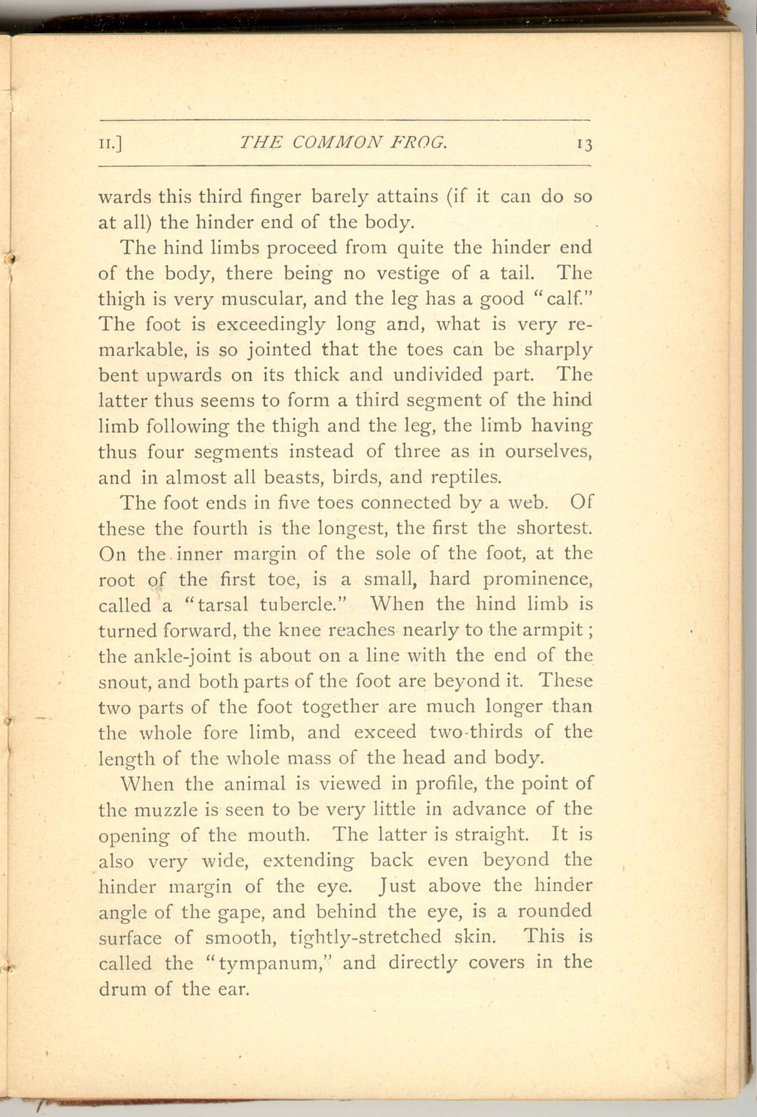 [Description:
Image of page 13.
]
[Description:
Image of page 13.
]
The hind limbs proceed from quite the hinder end of the body, there being no vestige of a tail. The thigh is very muscular, and the leg has a good "calf." The foot is exceedingly long and, what is very remarkable, is so jointed that the toes can be sharply bent upwards on its thick and undivided part. The latter thus seems to form a third segment of the hind limb following the thigh and the leg, the limb having thus four segments instead of three as in ourselves, and in almost all beasts, birds, and reptiles.
The foot ends in five toes connected by a web. Of these the fourth is the longest, the first the shortest. On the inner margin of the sole of the foot, at the root of the first toe, is a small, hard prominence, called a "tarsal tubercle." When the hind limb is turned forward, the knee reaches nearly to the armpit; the ankle-joint is about on a line with the end of the snout, and both parts of the foot are beyond it. These two parts of the foot together are much longer than the whole fore limb, and exceed two-thirds of the length of the whole mass of the head and body.
When the animal is viewed in profile, the point of the muzzle is seen to be very little in advance of the opening of the mouth. The latter is straight. It is also very wide, extending back even beyond the hinder margin of the eye. Just above the hinder angle of the gape, and behind the eye, is a rounded surface of smooth, tightly-stretched skin. This is called the "tympanum," and directly covers in the drum of the ear.
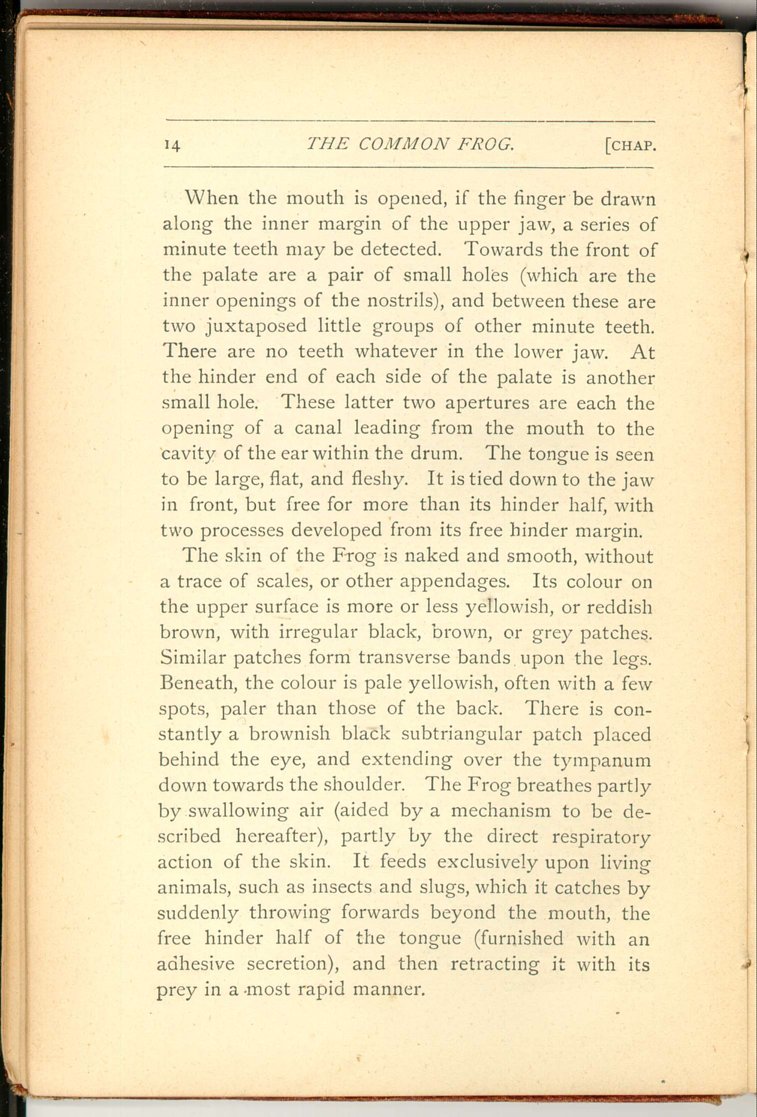 [Description:
Image of page 14.
]
[Description:
Image of page 14.
]
When the mouth is opened, if the finger be drawn along the inner margin of the upper jaw, a series of minute teeth may be detected. Towards the front of the palate are a pair of small holes (which are the inner openings of the nostrils), and between these are two juxtaposed little groups of other minute teeth. There are no teeth whatever in the lower jaw. At the hinder end of each side of the palate is another small hole. These latter two apertures are each the opening of a canal leading from the mouth to the cavity of the ear within the drum. The tongue is seen to be large, flat, and fleshy. It is tied down to the jaw in front, but free for more than its hinder half, with two processes developed from its free hinder margin.
The skin of the Frog is naked and smooth, without a trace of scales, or other appendages. Its colour on the upper surface is more or less yellowish, or reddish brown, with irregular black, brown, or grey patches. Similar patches form transverse bands upon the legs. Beneath, the colour is pale yellowish, often with a few spots, paler than those of the back. There is constantly a brownish black subtriangular patch placed behind the eye, and extending over the tympanum down towards the shoulder. The Frog breathes partly by swallowing air (aided by a mechanism. to be described hereafter), partly by the direct respiratory action of the skin. It feeds exclusively upon living animals, such as insects and slugs, which it catches by suddenly throwing forwards beyond the mouth, the free hinder half of the tongue (furnished with an adhesive secretion), and then retracting it with its prey in a most rapid manner.
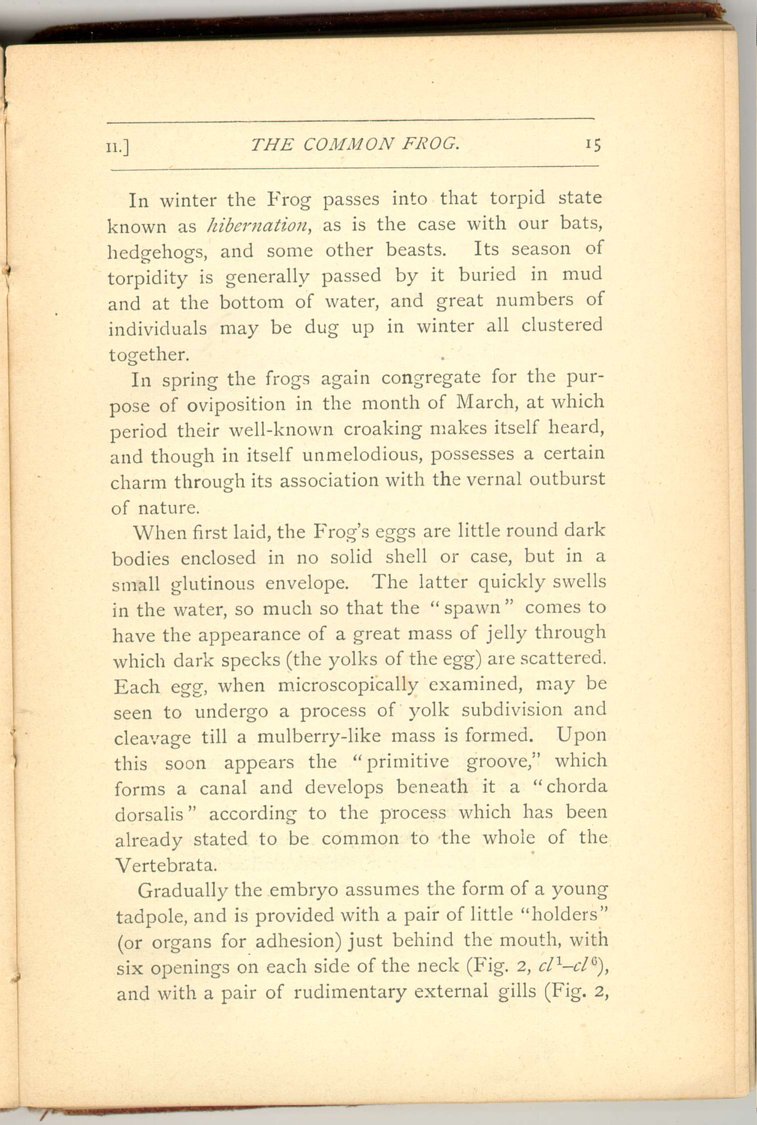 [Description:
Image of page 15.
]
[Description:
Image of page 15.
]
In winter the Frog passes into that torpid state known as hibernation, as is the case with our bats, hedgehogs, and some other beasts. Its season of torpidity is generally passed by it buried in mud and at the bottom of water, and great numbers of individuals may be dug up in winter all clustered together.
In spring the frogs again congregate for the purpose of oviposition in the month of March, at which period their well-known croaking makes itself heard, and though in itself unmelodious, possesses a certain charm through its association with the vernal outburst of nature.
When first laid, the Frog's eggs are little round dark bodies enclosed in no solid shell or case, but in a small glutinous envelope. The latter quickly swells in the water, so much so that the "spawn" comes to have the appearance of a great mass of jelly through which dark specks (the yolks of the egg) are scattered Each egg, when microscopically examined, may be seen to undergo a process of yolk subdivision and cleavage till a mulberry-like mass is formed. Upon this soon appears the "primitive groove," which forms a canal and develops beneath it a "chorda dorsalis" according to the process which has been already stated to be common to the whole of the Vertebrata.
Gradually the embryo assumes the form of a young tadpole, and is provided with a pair of little "holders" (or organs for adhesion) just behind the mouth, with six openings on each side of the neck (Fig. 2, cl¹-cl6), and with a pair of rudimentary external gills (Fig. 2,
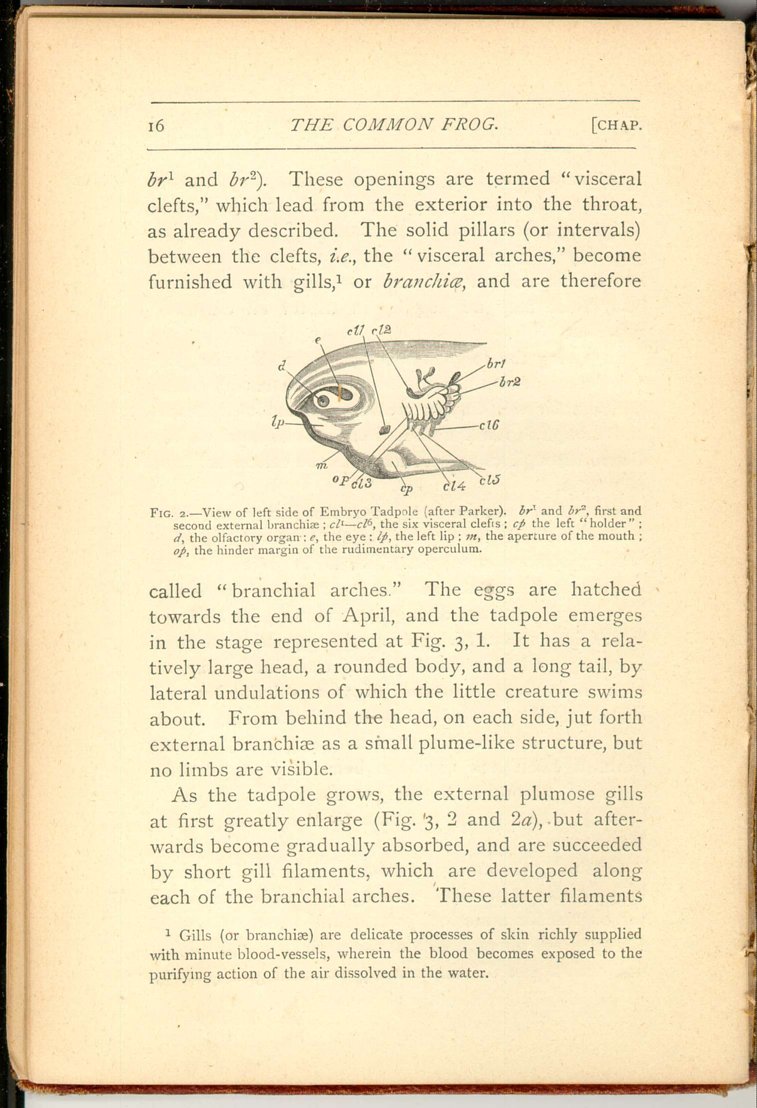 [Description:
Image of page 16.
]
[Description:
Image of page 16.
]
As the tadpole grows, the external plumose gills at first greatly enlarge (Fig. 3, 2 and 2 a.), but afterwards become gradually absorbed, and are succeeded by short gill filaments, which are developed along each of the branchial arches. These latter filaments
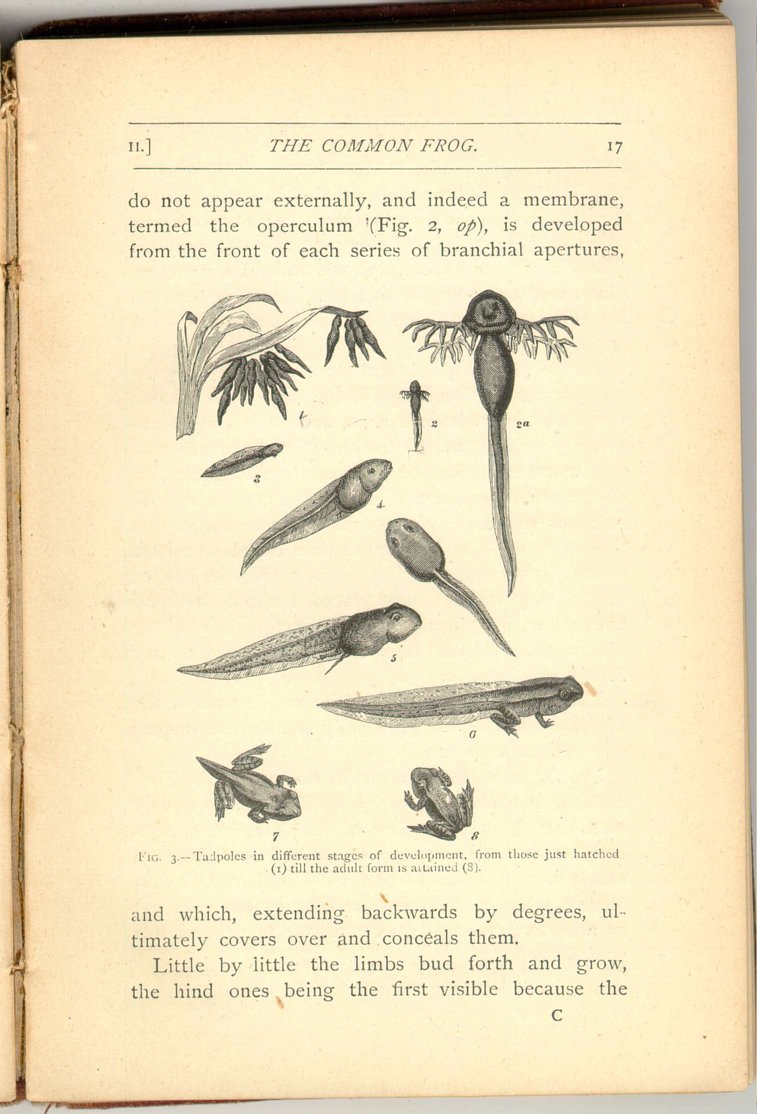 [Description:
Image of page 17.
]
[Description:
Image of page 17.
]
Little by little the limbs bud forth and grow, the hind ones being the first visible because the
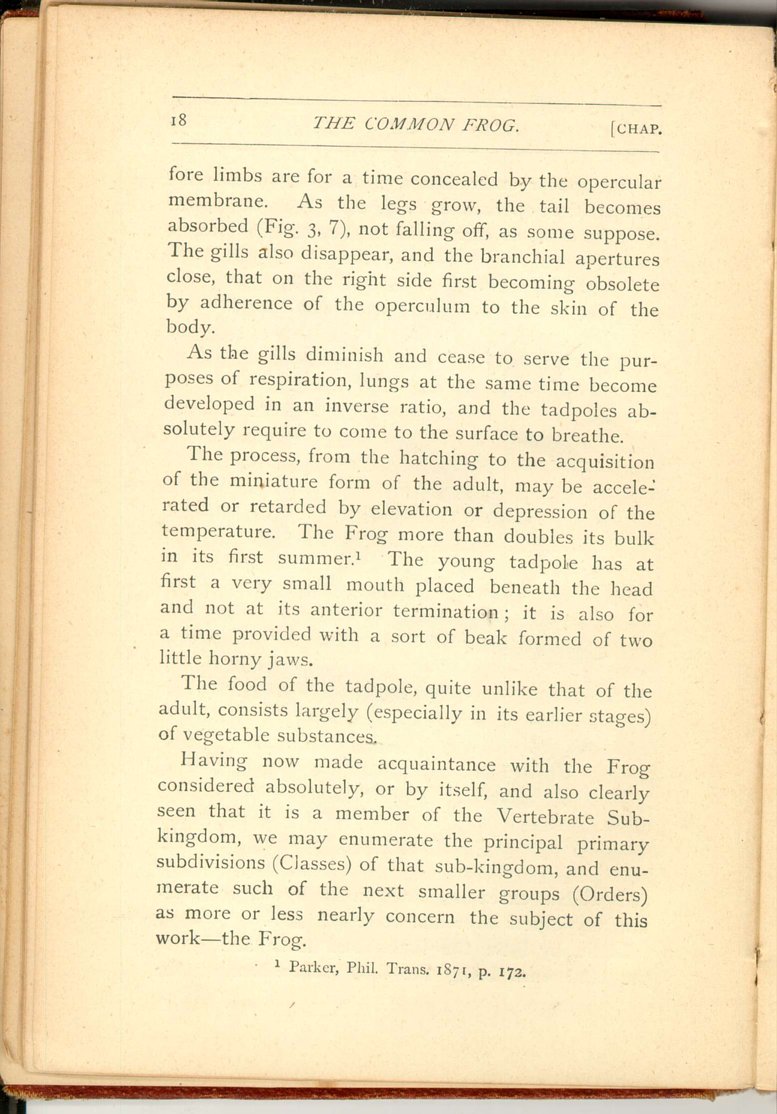 [Description:
Image of page 18.
]
[Description:
Image of page 18.
]
As the gills diminish and cease to serve the purposes of respiration, lungs at the same time become developed in an inverse ratio, and the tadpoles absolutely require to come to the surface to breathe.
The process, from the hatching to the acquisition of the miniature form of the adult, may be accelerated or retarded by elevation or depression of the temperature. The Frog more than doubles its bulk in its first summer. [7] The young tadpole has at first a very small mouth placed beneath the head and not at its anterior termination; it is also for a time provided. with a sort of beak formed of two little horny jaws.
The food of the tadpole, quite unlike that of the adult, consists largely (especially in its earlier stages) of vegetable substances.
Having now made acquaintance with the Frog considered absolutely, or by itself, and also clearly seen that it is a member of the Vertebrate Sub-kingdom, we may enumerate the principal primary subdivisions (Classes) of that sub-kingdom, and enumerate such of the next smaller groups (Orders) as more or less nearly concern the subject of this work—the Frog.
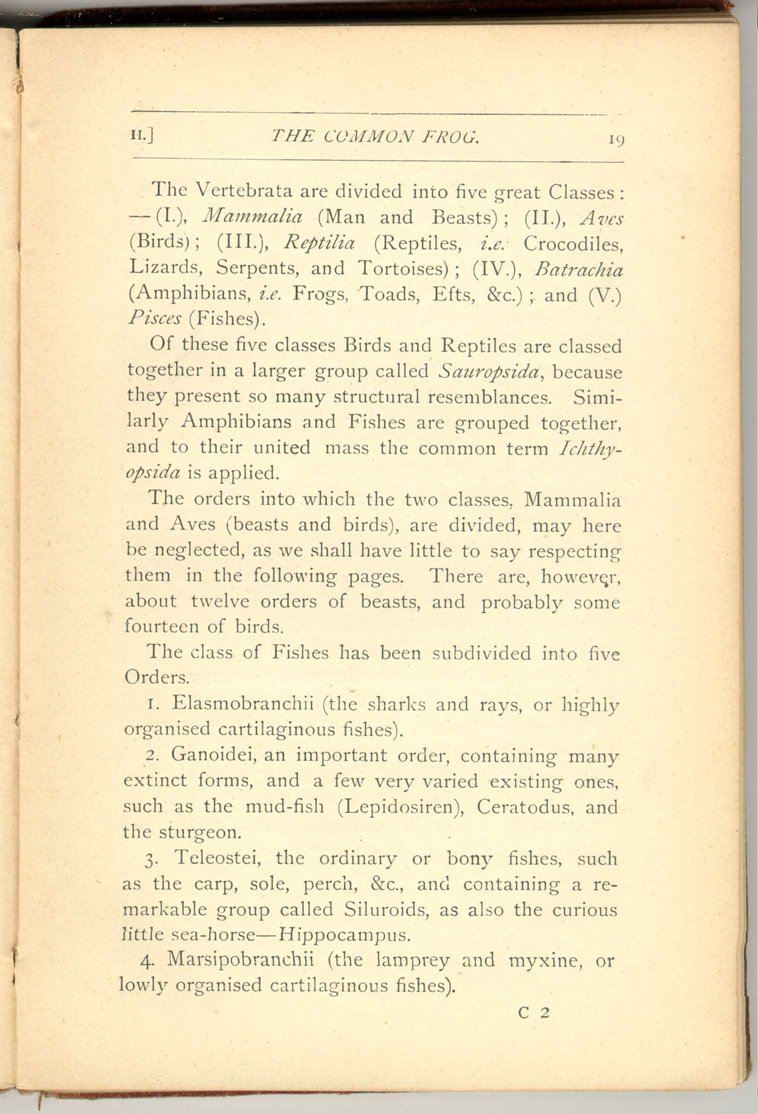 [Description:
Image of page 19.
]
[Description:
Image of page 19.
]
The Vertebrata are divided into five great Classes:—(I.), Mammalia (Man and Beasts); (II.), Aves (Birds); (III.), Reptilia (Reptiles, i.e. Crocodiles, Lizards, Serpents, and Tortoises); (IV.), Batrachia (Amphibians, i.e. Frogs, Toads, Efts, &c.); and (V.) Pisces (Fishes).
Of these five classes Birds and Reptiles are classed together in a larger group called Sauropsida, because they present so many structural resemblances. Similarly Amphibians and Fishes are grouped together, and to their united mass the common term Ichthyopsida is applied.
The orders into which the two classes, Mammaliaand Aves (beasts and birds), are divided, may here be neglected, as we shall have little to say respecting them in the following pages. There are, however, about twelve orders of beasts, and probably some fourteen of birds.
The class of Fishes has been subdivided into five Orders.
1. Elasmobranchii (the sharks and rays, or highly organised cartilaginous fishes).
2. Ganoidei, an important order, containing many extinct forms, and a few very varied existing ones, such as the mud-fish ( epidosiren), Ceratodus, and the sturgeon.
3. Teleostei, the ordinary or bony, fishes, such as the carp, sole, perch, &c., and containing a remarkable group called Siluroids, as also the curious little sea-horse—Hippocampus.
4. Marsipobranchii (the lamprey and myxine, or lowly organised cartilaginous fishes).
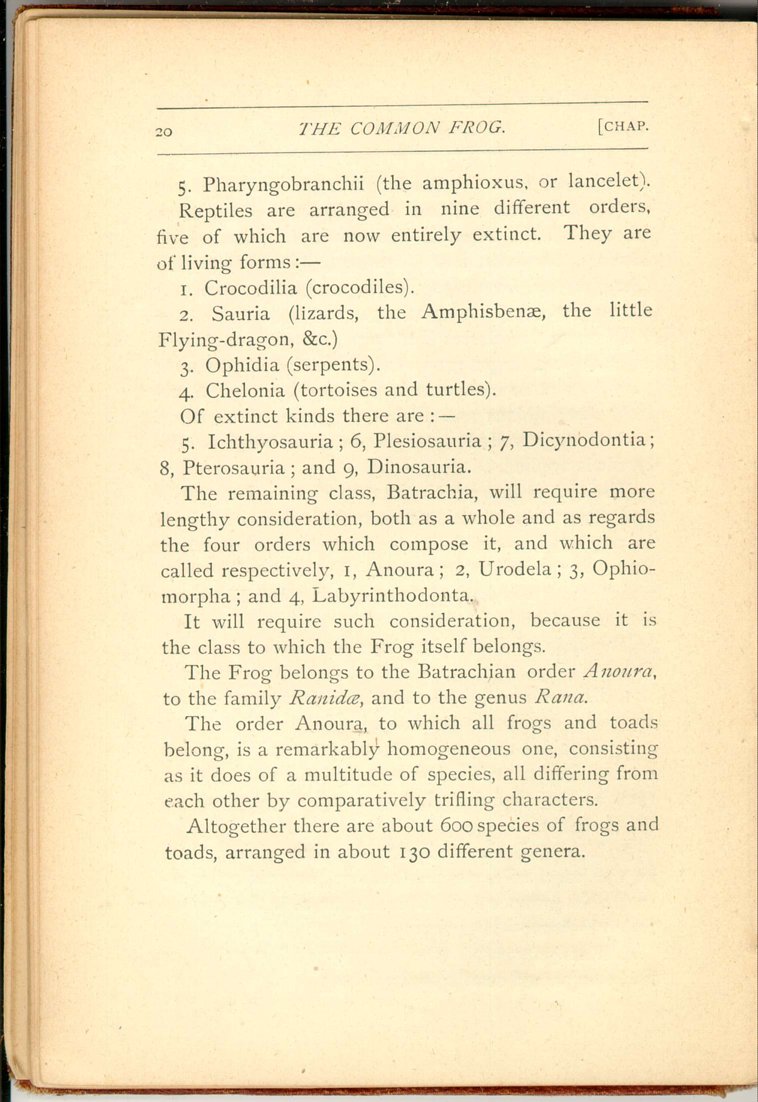 [Description:
Image of page 20.
]
[Description:
Image of page 20.
]
5. Pharyngobranchii (the amphioxus, or lancelet).
Reptiles are arranged in nine different orders, five of which are now entirely extinct. They are of living forms:—
- 1. Crocodilia (crocodiles).
- 2. Sauria (lizards, the Amphisbenæ, the little Flying-dragon, &c.)
- 3. Ophidia (serpents).
- 4. Chelonia (tortoises and turtles).
Of extinct kinds there are:—
- 5. Ichthyosauria;
- 6, Plesiosauria
- 7, Dicynodontia;
- 8, Pterosauria; and
- 9, Dinosauria.
The remaining class, Batrachia, will require more lengthy consideration, both as a whole and as regards the four orders which compose it, and which are called respectively, 1, Anoura; 2, Urodela; 3, Ophiomorpha; and 4, Labyrinthodonta.
It will require such consideration, because it is the class to which the Frog itself belongs.
The Frog belongs to the Batrachian order Anoura,to the family Ranidæ, and to the genus Rana.
The order Anoura, to which all frogs and toads belong, is a remarkably homogeneous one, consisting as it does of a multitude of species, all differing from each other by comparatively trifling characters.
Altogether there are about 600 species of frogs and toads, arranged in about 130 different genera.
FOOTNOTES: Chapter 2
|
CHAPTER II.
The Common Frog | ||